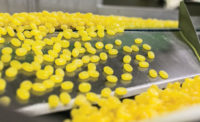The global snack food packaging market is expected to reach market valuation of US $25.9 billion by the end of 2031 from US $17 billion in 2020. Increasing intake of various packaged snack food products such as chips, bakery and confectionary, ready-to-eat food, etc. has accentuated the demand for innovative and efficient packaging solutions.
Packaging for snack food items plays a significant role in preserving the product's flavor, texture, and quality. Snack food packaging is becoming more popular among people of all age groups, prompting producers to introduce new and appealing package designs that help to maximize product visibility. In addition, as the urban population inclines toward snack foods, the demand for packaging solutions is also growing. Due to their bulk orders of packaged snack food products, city-based companies have increased their demand for improved packaging solutions.
Companies in the global snack food packaging market are boosting the production of single serving packaging solutions in response to growing focus on food hygiene and safety amid the current COVID-19 pandemic. As a result, manufacturers are investing more in R&D to produce sustainable materials, such as paper and recycled plastic, in order to address both sustainability and rising problems of plastic waste. Companies are personalizing consumer experience by spending more on automated packaging machinery that assist in mass-producing packaging solutions designed to meet specific requirements.
Request a report sample here.
Key findings of market report
- Packaging solutions assist in meeting the demand for health-conscious and on-the-go customers. In order to accomplish this, producers are boosting the manufacturing of bag closures, which aid in the re-closing of packaging, allowing consumers to enjoy the remainder of the product at a later time.
- The food industry has substantially high demand for flexible packaging. Snack food packaging companies are ramping up manufacturing of flexible packaging in order to increase the availability of bags, pouches, and stick packs.
- Confectionery packaging makers are increasingly focusing on paper-based packaging in order to make their products more environment-friendly. For premium chocolates, kraft paper can be utilized as a packaging solution. Since they are recyclable, they are ecologically sustainable raw material. For moisture-sensitive confectionery products and chewing gums, heat-sealed, wax laminated, and wax coated paper packaging are favored packaging options.
- Due to its eco-friendly as well as cost-effective attributes, composite cans are anticipated to replace metal cans in the global snack food packaging market. Consumers are favoring composite cans, particularly for the packaging of granular and dry food products.
- With customer convenience at the forefront, innovation in product design is a key factor that is likely to drive revenue generation opportunities in the global market. Manufacturers of snack food packaging solutions are focusing on the inclusion of unique qualities, including high durability, superior gloss and brightness, extended shelf life, barrier properties, etc.
Snack food packaging market: Growth drivers
It has been observed that single-serve packaging helps in more accurate portion management. As a result, snack food packaging producers are increasing manufacturing of single serving packaging solutions. Not only have these innovations resulted in new snack varieties, but they have also contributed to the development of eco-friendly packaging solutions.
In terms of volume and value, Asia Pacific is likely to be one of the leading regions in the global snack food packaging market. The consumption of namkeen or salty snacks is widespread in India, which is predicted to drive revenue in the regional market.





